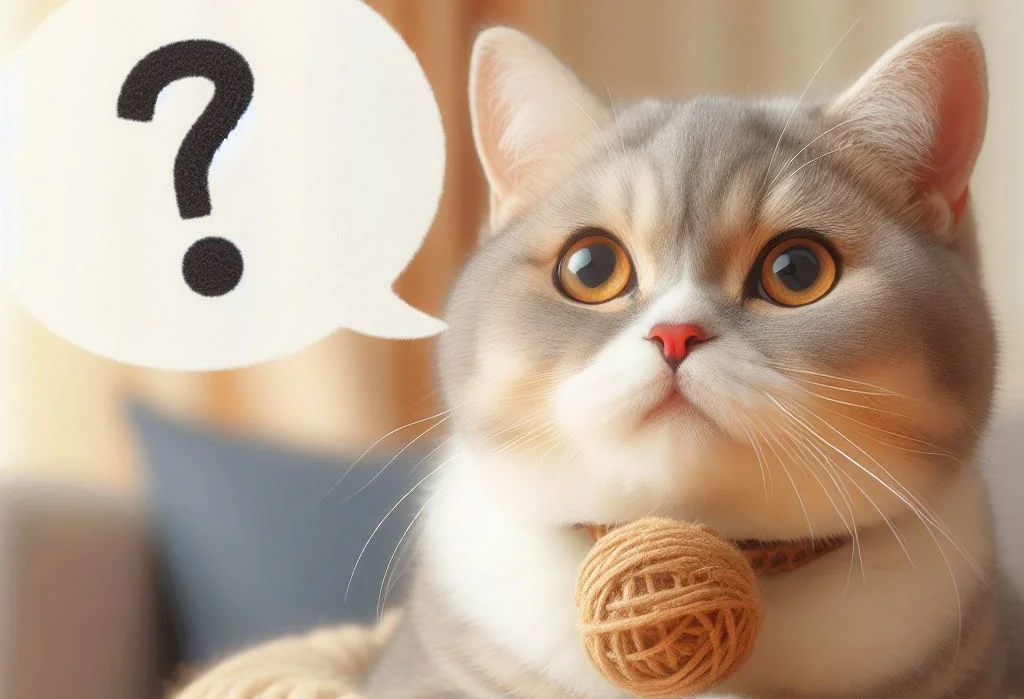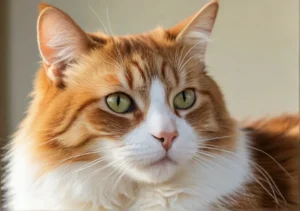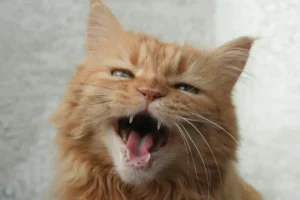Does your chatty cat have you wondering if they’re plotting world domination or just commenting on your cooking? Either way, their constant vocalizations aren’t just adorable (or occasionally judgmental); they’re a form of feline communication that’s as complex as it is cute.
If you’re perplexed by your kitty’s ceaseless meowing, this post promises to soothe your frazzled nerves with insights and fun facts about why your feline friend is so talkative. You’ll walk away understanding your cat a bit better, and who knows, you might even improve your “conversations”!
Quick Takeaways:
- Cats’ meows vary in meaning; observe body language for a better understanding.
- Siamese and Bengal are among the breeds known for being more vocal.
- Regular “chatting” routines and a stimulating environment can improve communication with your cat.
Is My Cat Trying to Communicate With Me?
Ever wondered why your cat seems to have a lot to say? Well, it turns out, they probably do. Cats use vocalizations as a primary method of communication, especially with their humans. When your furry friend meows, they might be trying to tell you a variety of things – from “I’m hungry” to “I just love your company”.
Cats develop a language of meows, purrs, and sometimes even yowls to express their feelings and desires. A soft, chirpy meow might mean your cat is happy and content, whereas a longer, more drawn-out meow could indicate they’re craving your attention. It’s fascinating once you start paying attention to these cues, transforming what might seem like random noises into meaningful communication.
Do Different Breeds Talk More?
Yes, indeed! Not all cats are created equal when it comes to chattiness. Siamese and Bengal cats, for instance, are known for being particularly vocal. Siamese cats, with their striking blue eyes, often engage in lengthy conversations, while Bengals have a unique way of expressing themselves with a wide range of sounds.
Why is that? Well, it boils down to genetics and breed behavior. These breeds have been selectively bred over generations, which has not only influenced their physical attributes but their communicative behavior as well. It’s like how some families are full of chatty individuals; the same goes for certain cat breeds.
How Does My Cat’s Environment Influence Their Chatter?
Believe it or not, the environment plays a huge role in how much your cat talks. A stimulating environment filled with opportunities for play, exploration, and interaction can lead to a more vocally expressive cat. In contrast, a lack of stimulation may cause your feline friend to either become more vocal in seeking attention or more withdrawn.
Here’s a unique tip most overlook: Create a “chat spot” in your home. This is a dedicated space where you engage in vocal back-and-forth with your cat. Use toys that mimic prey, like a feather on a string, to make your cat chirp and chatter excitedly. By responding to them, you’re acknowledging their efforts to communicate, reinforcing this behavior in a positive manner. Not only does this strengthen your bond, but it also provides much-needed mental stimulation for your cat.
In summary, cats are complex creatures with a deep repertoire of vocalizations. Whether your cat is a talkative Siamese or a more reserved tabby, understanding and responding to their attempts at communication can enrich your relationship in ways you might not have imagined. Keep an ear out for those meows, chatters, and purrs – they’re your cat’s way of opening a fascinating dialog with you!

Can Health Issues Cause Excessive Meowing?
Yes, indeed, excessive meowing might sometimes be more than just a quirky habit; it could be a red flag waving high, suggesting that all is not well with your feline friend. Cats, by their nature, can be quite vocal, but when the chatter turns into a constant monologue, it’s time to pay attention. Several health issues can cause your cat to talk more than usual, and deciphering these signs early can make a world of difference.
Hyperthyroidism , primarily seen in older cats, can cause a variety of symptoms, including increased meowing or vocalization. This condition occurs when the thyroid gland produces too much thyroid hormone, affecting the cat’s metabolism. Look out for other signs like weight loss despite a good appetite, increased thirst, and hyperactivity.
Hearing loss is another condition that can lead to louder or more frequent meowing. As their sense of hearing diminishes, cats might vocalize louder to compensate for their loss. If you notice your cat not responding to sounds as they once did, it’s time for a vet visit.
Cognitive Dysfunction Syndrome (CDS) , akin to dementia in humans, affects many cats in their senior years. Disorientation and confusion can lead to increased vocalization, especially during the night. If you notice changes in your cat’s sleep patterns, disorientation, or altered interactions, these could be signs of CDS.
Pain or discomfort can also increase your cat’s vocalizations. Whether it’s dental pain, arthritis, or an internal issue, cats might meow more as a way of communicating their discomfort. Watch for changes in behavior, such as decreased activity, lack of appetite, or avoiding touch.
When to consult with a vet? If the increase in meowing is sudden, persistent, or accompanied by other signs of illness, it’s time to reach out. Remember, you know your cat best. Any significant change in behavior warrants professional advice.
What Can You Do to Better Understand and Respond to Your Cat’s Chatter?
Cats are complex creatures with a language all their own. Understanding and responding to your cat’s chatter not only strengthens your bond but also ensures their needs are met. Here’s how to tune in and effectively communicate with your furry linguist:
-
Observe Their Body Language: Your cat’s meows come in a package deal with tail flicks, ear movements, and body posture. A relaxed posture with a tail held high suggests a happy meow, while an arched back or puffed-up tail could indicate fear or aggression.
-
Consistency is Key: Cats learn from repetition. Using a consistent response to their vocalizations helps them understand what we’re communicating back to them. If your cat meows to go outside, for instance, only open the door when they sit quietly. This reinforces a quieter behavior for getting what they want.
-
Enrich Their Environment: Sometimes, cats meow out of boredom or to grab your attention. Make sure they have plenty of toys, scratching posts, and perches by windows to keep them entertained. Interactive puzzle feeders can also keep them mentally stimulated.
-
Unique Tip: Create a “chatting” routine. Cats love ritual, and setting aside a time each day for a back-and-forth “conversation” can satisfy their need for attention and communication. During this time, respond to your cat’s meows with soft, gentle tones or mimic their sounds. This can be a special bonding time and also a way to give your cat a vocal outlet in a controlled manner.
Interpreting and responding to your cat’s communications can be incredibly rewarding. It’s a dialogue that deepens your connection and enhances the harmony in your home. Remember, every cat has its unique dialect. With patience, observation, and a bit of intuition, you’ll soon get the gist of what your furry friend is trying to convey.
By tuning into their needs, both physical and emotional, you’ll not only address the immediate question of “Why does my cat talk so much?” but also foster a deeper, more communicative relationship with your feline companion.
Alex, a passionate animal lover, has experience in training and understanding animal behavior. As a proud pet parent to two dogs and three cats, he founded AnimalReport.net to share insights from animal experts and expand his knowledge of the animal kingdom.





